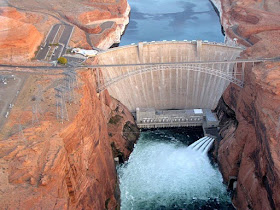Completed in 1966, the massive concrete structure of Glen Canyon Dam holds back Lake Powell, one of the largest man-made reservoirs in the world. (NPS Photo by S. Rohde)
By Dave Buchanan
Grand Junction Daily Sentinel
Lake Powell, which helps moderate water levels in Lake Mead, acts as a “savings account” for the states in the Upper Basin of the Colorado River.
In the years when the Upper Basin can’t meet its water-sharing obligations as required in the 1922 Colorado River Compact, water is released from the Lake Powell “account” for Lower Basin use.
But what happens when that Lake Powell account is over-drawn?
One is the potential impacts of a declining Lake Powell is the potential impact on power generation.
If Lake Powell drops below 3,490 feet above sea level (on Oct. 28 the level was 3,611 feet or 58 percent full), there no longer is enough water in the reservoir to push through the eight giant turbines.
This potential shortage of power in the western grid would have to be covered by changes in power generation at Blue Mesa, Flaming Gorge and Navajo dams.
“The likely first trigger we run into, the first cataclysm, is Lake Powell reaching a level where” power is not being produced, said Chris Treece of the Colorado River District. “That has impacts to all the power customers and not getting that revenue from the power impacts us in Colorado and in Grand Junction in particular.”
According to the Bureau of Reclamation, Lake Powell each year averages $150 million in power revenue and makes enough electricity to power more than 320,000 homes. The federal endangered fish recovery program is funded by power revenues, as is the salinity control program in the Paradox Valley and the adaptive management program for the Grand Canyon.
According to the Department of the Interior, the Grand Canyon plan provides even monthly volume releases and allows experimental releases to restore sand features and key fish and wildlife habitat, increase beaches and enhance wilderness values along the Colorado River.
Plus, low levels mean not enough push to get the water through the tubes and into the lower river.
“And if we are not sending water through the turbines, just the bypass tubes, we are on a mathematical certainty that we will not be able to provide 8.23 (million acre feet) over the long haul, and won’t have enough pressure and size to push that quantity of water through the dam,” Treece said.
During her presentation earlier this month, Secretary of the Interior Sally Jewell said there is a “50/50 chance” the upper basin will see water shortage.
“Ten years ago most people were dismissing any chance of the Upper Basin having a water shortage or being out of compliance with the compact obligations,” Treece said. “Now, it’s pretty much widely accepted that it’s a probability greater than zero. And that’s a real significant change in the dialogue.”
The underlying key is to plan ahead, not simply hope for more snow this winter.
“Lake Powell is the savings account for all of the Upper Basin,” Treece said. “If we draw down the account, there is that much less we have in the bank unless we get nice bonus check in next spring’s runoff.
“You can plan for a good snowpack but that’s not enough planning,” he cautioned. “It’s all about planning.”
